Leonardo da Vinci, painting "The Annunciation": history of creation, description of the painting, reproduction. Biblical scenes in the paintings of Leonardo da Vinci
Biblical subjects in the painting of Leonardo da Vinci, as well as in the painting of other artists of his time, occupy a significant place.
The first painting attributed to Leonardo is the Annunciation, although its authorship is disputed by many experts. However, this does not apply to the Annunciation painting alone. Unfortunately, the unknown author made later corrections, which significantly worsened the quality of the master's work.
Leonardo da Vinci "The Annunciation" (1472-1475)

Board, oil. 98x217 cm. Uffizi (Florence)
Picture from Wikipedia
The plot of the "Annunciation" is from the Gospel, it tells about the announcement by the archangel Gabriel to the Virgin Mary about the future birth of Jesus Christ.
Gabriel reveals the secret knowledge of God. According to the Gospel of Luke, Gabriel was sent by God to Nazareth to the Virgin Mary to announce to her the good news about the future birth of Jesus Christ in the flesh from her: “The angel, having entered to Her, said: Rejoice, Blessed One! The Lord is with you; Blessed are You among women. She, seeing him, was embarrassed by his words and wondered what kind of greeting it would be. And the angel said to her: Fear not, Mary, for you have found grace with God; and behold, thou shalt conceive in the womb, and thou shalt bear a Son, and thou shalt call his name: Jesus. He will be great and will be called the Son of the Most High, and the Lord God will give Him the throne of David His father; and he will reign over the house of Jacob forever, and his kingdom will have no end” (Gospel of Luke, 1, 28-33).
Description of the picture
Archangel Gabriel is depicted kneeling with a white lily in his left hand (a symbol of the purity of the Virgin Mary). With his right hand, he blesses Mary sitting at his house.
The Virgin Mary is depicted with a Bible (a tribute to tradition).
The realism of the picture ends there. The rich house, towers and walls of the port city in the background evoke a big city in our imagination. But there are no mentions of Nazareth in the historical texts of the first centuries, which suggests that it was very small city or a village.
The city of Nazareth is located in the lower Galilee - in a beautiful valley surrounded by mountains.

Nazareth. contemporary photography
Author: StateofIsrael - Nazareth, from Wikipedia
But the peaks of the mountains shrouded in a pale blue haze are still the same...
A. Verrocchio "The Baptism of Christ" (1475)
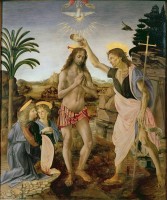
Wood, oil. 177x151 cm. Uffizi (Florence)
Andrea del Verrocchio(1435-1488) - Italian sculptor and painter of the Renaissance, one of the teachers of Leonardo da Vinci. Verrocchio was more involved in sculpture, but sometimes turned to painting. He brought up, in addition to Leonardo da Vinci, and other geniuses of the Renaissance: Pietro Perugino and Sandro Botticelli.
In this painting, some elements of the landscape and the fair-haired angel on the left are painted by Leonardo. The famous legend of the “defeated teacher” is connected with this circumstance: Verrocchio was so shocked by the skill of his student that after that he abandoned the brush.
Leonardo da Vinci "The Last Supper" (1495-1498)

460x880 cm. Santa Maria delle Grazie (Milan)
This monumental painting was made for the Dominican monastery of Santa Maria delle Grazie in Milan.
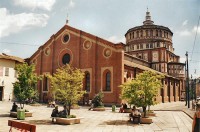
Santa Maria delle Grazie
Author: Abelson from the English Wikipedia
The Last Supper - an event last days earthly life of Jesus Christ, about which all four Gospels tell, as well as the 1st letter of the Apostle Paul to the Corinthians.
Jesus sent two disciples, Peter and John, to Jerusalem to prepare the Passover meal, and they did. Jesus lay down with the twelve disciples at a meal, during which He foretold the betrayal of one of them. At the Last Supper, Christ established the main sacrament of the Christian faith - the Eucharist, which in Greek means "thanksgiving". The events of the Last Supper are constantly remembered during the celebration of the Liturgy, before Communion.
The Last Supper is the subject of many icons and paintings, of which the most famous is The Last Supper by Leonardo da Vinci.
This image is located in the refectory of the monastery, on the back wall. This painting became a masterpiece of the Renaissance thanks to Leonardo's technique: it correctly reproduces the depth of perspective. It was the painting "The Last Supper" by Leonardo da Vinci that changed the direction of development of Western painting.
Leonardo's painting cannot be called a fresco in the full sense of the word, because the fresco is created on wet plaster, and Leonardo da Vinci painted The Last Supper on a dry wall. A fresco cannot be changed while it is being painted, and Leonardo decided to cover the stone wall with a layer of resin, gabs, and mastic, and then paint over this layer. tempera(water-borne paints prepared on the basis of dry powder pigments. The binder of tempera paints are emulsions: natural (chicken egg yolk diluted with water or a whole egg) or artificial (drying oils in an aqueous solution of glue, polymers).
In the center of the image is Jesus Christ. Around Him are depicted the apostles sitting in groups (from left to right): Bartholomew, Jacob Alfeev and Andrei; Judas Iscariot (dressed in green and blue), Peter and John; Thomas, James Zebedee and Philip; Matthew, Judas Thaddeus and Simon.
The moment is depicted when Jesus utters the words that one of the apostles will betray him, and the reaction of each of them to these words.
Judas has a small pouch in his hand, possibly containing the silver he received for betraying Jesus, or simply designating him as treasurer.
The figure of Jesus is located and illuminated so that the viewer's attention is drawn to Him. The light illuminating the whole scene does not come from the windows drawn at the back, but comes from the left.
Already in 1517, the paint of the painting began to peel off due to moisture, so repeated restorations were carried out. From 1978 to 1999 Under the leadership of Pinin Brambilla Barchilon, a large-scale restoration was carried out.
Leonardo da Vinci "The Savior of the World" (circa 1499)
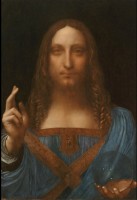
Wood panel, oil. 66x47 cm. Private collection (New York)
The authorship of this painting, as well as other works by Leonardo da Vinci, has long been questioned. In 2004, at one of the auctions, this work was purchased by Robert Simon, a specialist in old masters, and sent for restoration. After that, the "Savior" was examined in several museums in Europe and the United States.
Attention is drawn to the high craftsmanship of glass powers(symbol state power monarch, which was a golden ball with a crown or cross), the airy lightness of blue robes, the use sfumato(developed by Leonardo da Vinci, the method of softening the outlines of figures and objects), full compliance of the pigments of the New York "Savior" and "Madonna in the Rocks" by Leonardo. And still the same light wandering Leonard smile...
In 2013, this canvas was bought by Russian billionaire Dmitry Rybolovlev.
Leonardo da Vinci "John the Baptist" (1514-1516)
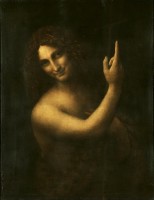
Wood, oil. 57x69 cm Louvre (Paris)
This work belongs to the late period of the artist's work.
The viewer's attention is completely concentrated on the depicted figure due to the absence of any landscape or interior. Reception is clear sfumato brought to perfection in this picture.
Formally, all the paraphernalia associated with John the Baptist is present: a thin reed cross, long hair, clothes made of wool. But...
John the Baptist was an ascetic. In the Gospel of Matthew, he is described as follows: "John himself had a garment of camel's hair and a leather belt around his loins, and his food was locusts (locusts) and wild honey" (Matt. 3:4).
The painting by Leonardo da Vinci depicts a pampered, effeminate young man, whose image does not fit in with the ascetic John, who ate locusts. There is no classical style in this canvas by Leonardo; the image of John the Baptist was already created in the style of mannerism, although this style arose much later. But Leonardo is also the founder here.
In the painting by A. Ivanov, we see a completely different image of John the Baptist, more similar to the description of the evangelists.

A. Ivanov "The Appearance of Christ to the People" (1837-1857)
Canvas, oil. 540x750 cm State Tretyakov Gallery (Moscow)
The figure of John the Baptist is in the center of the picture. He performs the baptism of the people in the Jordan River and points to the approaching Jesus. The attributes of John are the same as those of Leonardo: a thin reed cross, long hair, clothes made of wool, but the ascetic image corresponds to the gospel description.
Every time I want to attach a picture to a magazine to let others admire it, I think about this: is it necessary to write something about it? On the one hand, I don’t set myself “educational” tasks, but just haphazardly and irregularly show what interests me (and if good quality caught). Plus there is a feeling of "everything is clear, what to say?" or "Well, everyone knows that already."
Here. And then I think: why did I decide that everyone should know "and so"? I myself know a lot outside of "my" sphere? Ha. Try asking me what a logarithm is. Or about Newton's law (I vaguely suspect that he is not alone). But I knew once, but I completely forgot, like the last Holmes.
What am I talking about?.. Ah, yes. Still, I will fasten some minimum information to the pictures, in case the same Holmes, but "non-humanitarian oriented" reads. :)
So, "Annunciation".
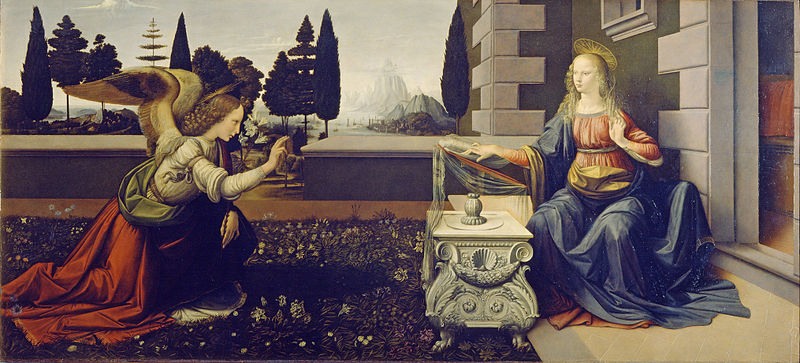
And along the way, the promised help.
The picture is painted in mixed media (oil, tempera) on a poplar board. Dated 1472-75.
There is not much historical information. The picture was introduced into scientific use in 1867. She was brought to the Uffizi Gallery from the monastery of St. Bartholomew, located near Florence. Several attribution options immediately arose: different researchers attributed the painting to a) Domenico Ghirlandaio, b) his son Ridolfo, c) Lorenzo di Credi, d) Verrocchio, e) Leonardo. There were also suggestions about the joint work of Ghirlandaio and Leonardo or Leonardo and di Credi. All these artists are quite closely related: Andrea Verrocchio was the owner of an art workshop in the 1470s, and Leonardo and di Credi were his students; Ghirlandaio either studied in this workshop or collaborated with it. Leonardo at this time was 20 years old or a little more.
It was possible to clarify the attribution after the discovery of two drawings by Leonardo. These are preparatory sketches for the painting - a fragment of an angel's hand (from Oxford) and draperies for the figure of Mary (Louvre).
Now about reproductions.
I, alas, have not seen the "Annunciation" live and cannot assess the fidelity of the color reproduction. The pictures found on the net differ in shades quite significantly. The one at the top is an option offered by the Uffizi Gallery and the Google Art Project. To be honest, this coldish glossiness confuses me a little. So here's another option:

Fragments:
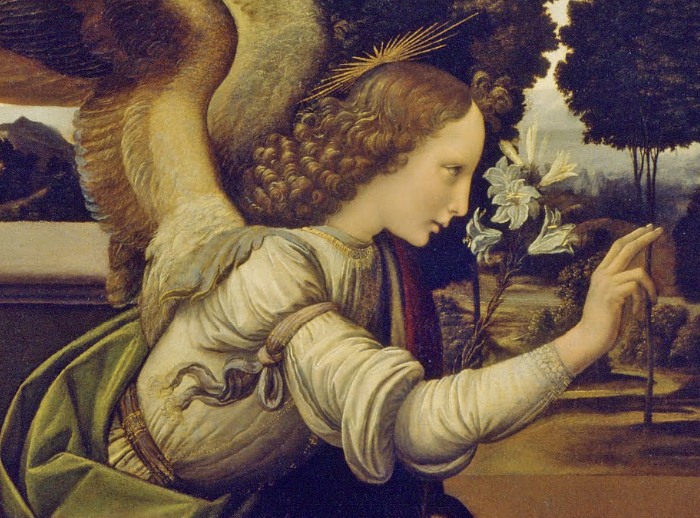
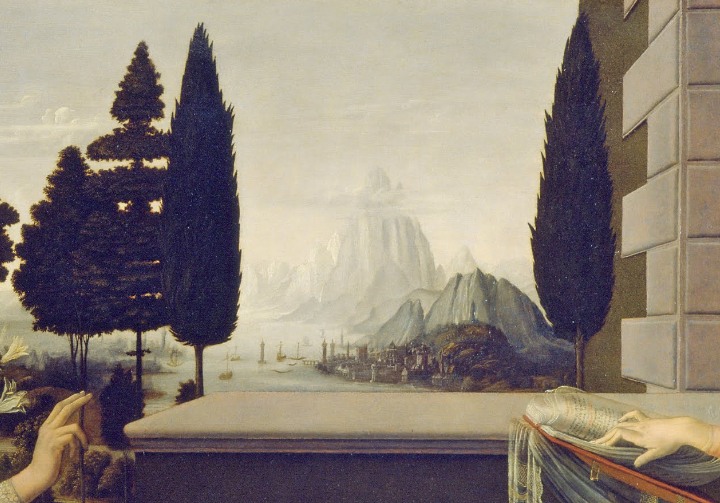
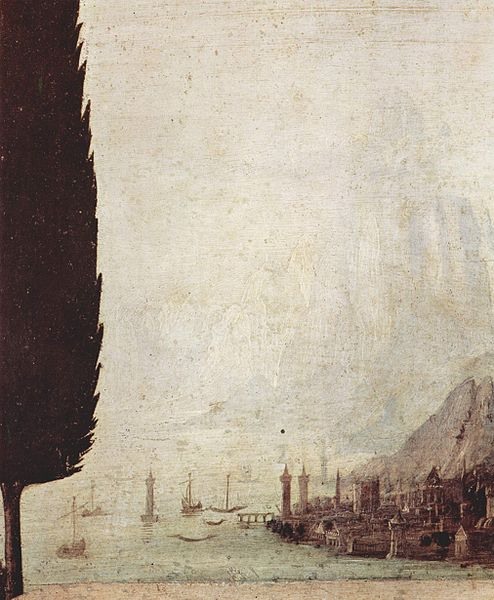

What do art historians usually say about this painting?
That her composition is quite traditional; of the characteristic attributes here are a lily (a symbol of purity and purity) and a book that Mary reads (it is believed that this is the book of the prophet Isaiah, which says "Behold, the Virgin will receive in the womb and give birth to a Son").
As an innovative feature, they note that both figures are depicted outdoors. In the medieval tradition, the scene of the Annunciation was almost always painted in the interior, often with a bed. At least the figure of Mary was always located indoors; an angel could be depicted outside the room, in a walled garden - this is the so-called hortus conclusus, "prisoner garden", symbolizing, along with a clogged vessel, the virgin bosom of the Mother of God.
In Leonardo, the angel and Mary are painted in the open air; nevertheless, there is a hint of a room with a bed, as well as a hortus conclusus, here turned into a lawn in front of an Italian palazzo.
They also note the naturalistically written wings of an angel and in this regard they recall that Leonardo studied the anatomy of birds.
What else? That in the depiction of the face and hair (especially with an angel) there is still no skill that distinguishes the paintings of the mature period: the colors are "flat", without the characteristic Leonard transparency.
That already in his early works, Leonardo begins to use an aerial perspective when working on backgrounds, in which objects that are far away seem to be shrouded in haze.
And, they also talk about "perspective errors" - this concerns the proportions of Mary's figure, especially her right hand. But other researchers, on the contrary, consider the distortions to be conscious and call them "anamorphic experiments" - supposedly Leonardo made a picture to order and, knowing where it would hang, painted from the point of view from the right and from below.
Like everything I had to say. True, why - I do not know. :))
P.S. About the difference in reproductions - it is possible that the matter is also in the restoration. Uffizi gives something modern look, but the very first (hand with a bible) and the very last (figure of Mary) pictures are taken from an album released by the French publishing house Flammarion in 1968.
Oh, by the way, Italian restorers are also a separate issue ...
Now I'll look on the net - if Grashchenkov's text is posted, I'll give a link.
In the meantime - for interest and for comparison - other Annunciations of the 15th century:
German master Conrad von Soest, 1403
Oil/Board (1475)
Description
The Annunciation is the first painting attributed to Leonardo. The picture was painted for the sacristy of the monastery of San Bartolomeo, which was located outside the gates of San Frediano southwest of the center of Florence, in the town of Monte Oliveto, Monte Oliveto. In the poses of Gabriel and Mary, the influence of Verrocchio and Botticelli close to him can be seen. Leonardo's hand is felt in the masterful depiction of the landscape, and especially in the transfer of the experiences stipulated by the canon only on the faces of the characters, without spectacular gestures and excessive pathos. An angel suddenly appeared and interrupted the reading of Mary. There is embarrassment and humility on her face, on the face of an angel - consciousness of the significance of the moment. In his left hand he holds a lily, a symbol...
The Annunciation is the first painting attributed to Leonardo. The picture was painted for the sacristy of the monastery of San Bartolomeo, which was located outside the gates of San Frediano southwest of the center of Florence, in the town of Monte Oliveto, Monte Oliveto. In the poses of Gabriel and Mary, the influence of Verrocchio and Botticelli close to him can be seen. Leonardo's hand is felt in the masterful depiction of the landscape, and especially in the transfer of the experiences stipulated by the canon only on the faces of the characters, without spectacular gestures and excessive pathos. An angel suddenly appeared and interrupted the reading of Mary. There is embarrassment and humility on her face, on the face of an angel - consciousness of the significance of the moment. In his left hand he holds a lily, the symbol of Florence. Leonardo's characteristic craving for the natural course of things is obvious.
The Annunciation is celebrated on March 25, and to create a spring mood, the lawn in front of Mary's house is strewn with flowers. In the future, Leonardo will show the flora only in natural conditions and in strict accordance with the season, which is given by the plot. In a departure from the canon, the wings of the archangel are not in his entire height, but shorter, like those of a bird. Later, an unknown artist lengthened them with chestnut paint, so that the original landscape shows through the ends of the wings. The Annunciation, a painting by the 20-year-old artist, combines innovative features and lyrics with quotations and errors. On the right side of the picture there are student miscalculations in perspective. So, the wall going to the cypress is a little short, and the lectern standing in front of the Virgin is too large.
It seems that he is closer to the viewer than Maria, which is why the artist had to lengthen her right hand, which lies on the book. And yet, contemporaries saw in this picture the work of a genius. Only one magnificent image of fabrics and draperies - distinguishing feature Leonardo - was admired by most of his colleagues.
History of a painting. The Annunciation by Leonardo da VinciLeonardo da Vinci "The Annunciation" (~1472-1475), oil and tempera on wood, 78x219cm, Uffizi Gallery Florence, Italy
In this large picture, Leonardo relied mainly on 15th-century illustrated Bibles:
Archangel Gabriel kneels in the garden of the Virgin, (Luke 1.26-38) who receives his message and learns that she has been chosen to give birth to the Son of God.
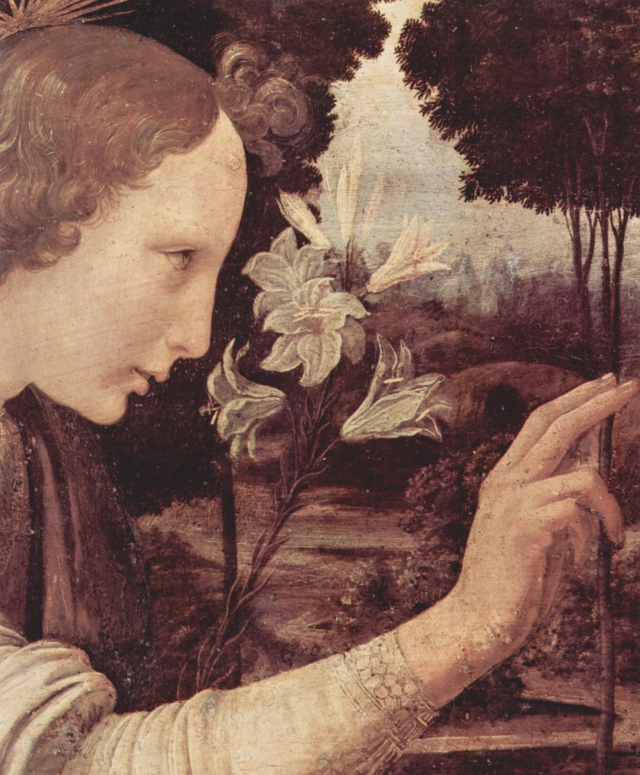
Archangel Gabriel
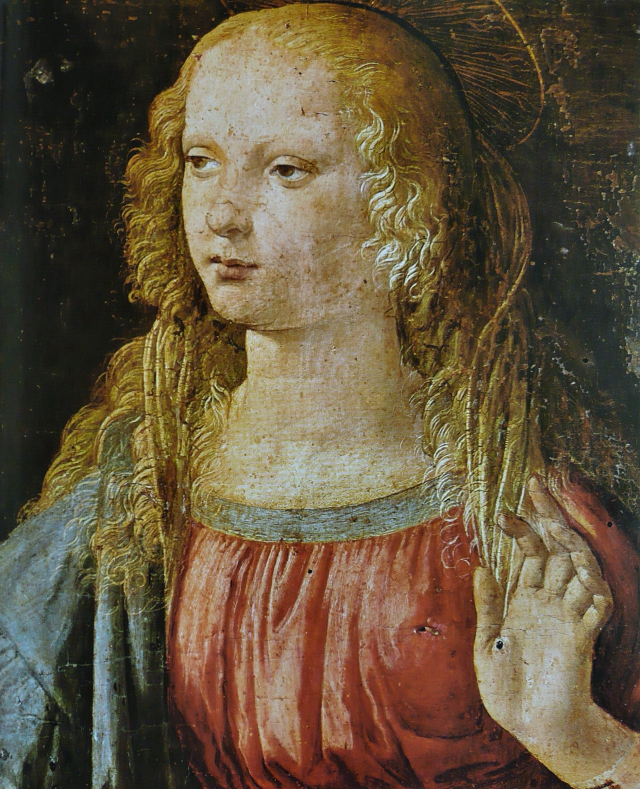
the Virgin Mary
The scene on the right corresponds to the architecture of that time.
The middle part is enclosed by a low wall, reaching knee height, with a small opening in the center. This opening, which serves as the backdrop for Gabriel's salutation gesture, with a lily in his left hand (a symbol of Mary's purity), also shows the path disappearing into the distance. Sharp silhouettes of trees and mountains are visible, against the backdrop of a blazing sky.
It was Leonardo who first showed this biblical scene not indoors, but used a masterfully executed landscape that enhances the impression of the picture.

Landscape: the port, ships, mountain peaks are clearly visible in the background
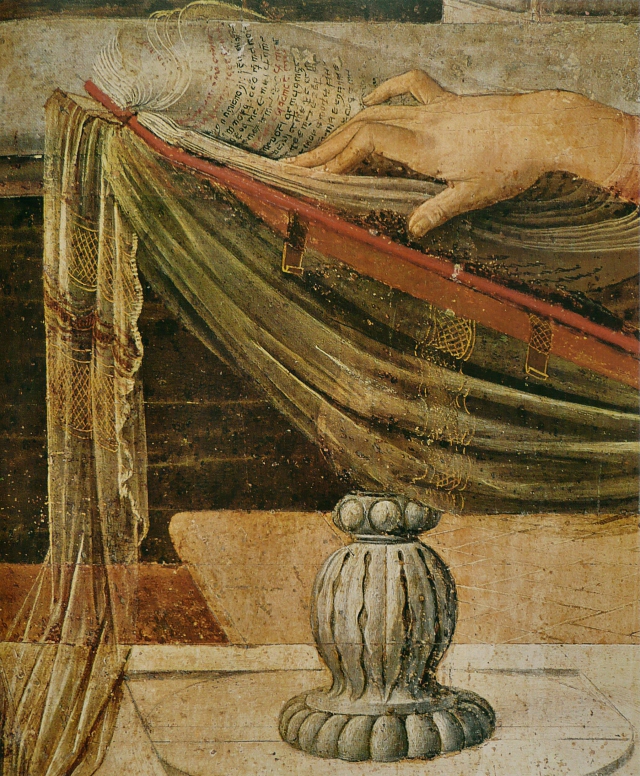
Bible and the hand of the Virgin Mary

Fragment of marble stand with relief
The work arrived at the Uffizi Gallery in 1867 from the monastery of San Bartolomeo (Monteoliveto), near Florence. Until 1869 it was considered the work of Domenico Ghirlandaio. Then scientists came to the conclusion that this is an early work of Leonardo, 1472-1475. when he was still a student of Verrocchio and worked in his workshop.
The landscape was not considered an independent genre in Italy. Leonardo was the first to give him great importance. Born and raised until the age of fourteen in the picturesque town of Vinci, he felt nature very subtly and deeply - he even once said that only she could be a "mentor of higher minds."
It is not surprising that the action of his first independent picture takes place against the backdrop of a magnificent Tuscan landscape. The sacred scene is shown in the garden of a Florentine palace, against the backdrop of a landscape that is created by mountains, water and sky, a magical and unreal atmosphere. This background defines the artist in many works.
Leonardo's individuality is also felt in the folds of the clothes of the Virgin and the Angel. In many sketches, he learns to convey the natural fall of the folds. The marble table probably points to the tomb of Piero and Giovanni de' Medici. in the church of San Lorenzo, which Verrocchio decorated with sculpture during this period.






